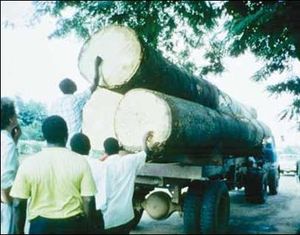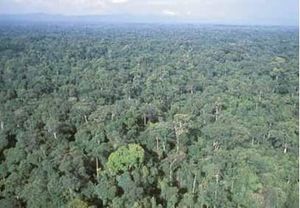Africa's renaissance for the environment: forests and woodlands
Contents
Issues

The forest sector plays an important role in the economic development of many countries and livelihoods of many communities in the region. On average, forests account for 6 per cent of GDP in the Africa region, which is the highest in the world. They provide resources for energy, food and medicines, as well as timber and non-timber forest products (NTFP) which have considerable potential to generate income. Forests and woodland can contribute to the long-term social and economic development goals of New Partnership for Africa's Development (NEPAD). They are also key environmental components, and have a fundamental link to the provision of other environmental goods and services. They are critical to the success of the other aspects of NEPAD’s Environmental action Plan (NEPAD-EAP) programmes, including combating land degradation and climate change, conserving wetlands, coastal and freshwater resources, and controlling alien invasive species.
Forests and woodlands have multiple values at all levels of human society, including the community, national, sub-regional, regional or global levels. At the local (community) level forests and woodlands have multiple uses, which vary extensively with the type of forest, and the community. These include construction materials, foods, energy, medicines, catchment protection, soil protection, shelter and shade, habitat for wildlife and grazing as well as cultural values (sacred groves, shade, peace trees and plants, meeting places, boundaries, training areas). Local communities therefore use forests and their products in a multitude of ways that differ from direct commercial exploitation or conversion to agricultural land. At the national level and regional level forests and woodlands also play an important role in catchment protection for water quality, hydropower, and regulation of river flows, prevention of soil erosion, timber products, biodiversity, non-timber forest products (food, materials, and medicinal substances), energy and leisure. At the global level they are valued for their role in climate regulation and as repositories for biodiversity.

However, forests in the region are declining in quantity and quality, due to a number of factors. Chief among them are demand for fuel and agricultural land, livestock production and plantations (rubber, coffee and cocoa), population growth, and infrastructure development. Other pressures include inappropriate forest policies, lack of enforcement, weak forest departments, and low investments in research, training and management. Management challenges include incomplete inventorying, poor monitoring and enforcement, poor governance (such as inadequate community involvement and decentralization) and inadequate valuation of natural resources (goods and services).
Urbanization is also a major driver of environmental degradation in its immediate vicinity, particularly deforestation due to increasing fuel wood demand from the urban poor and pollution resulting from improper location of garbage disposal sites.
Conflicts have also taken their toll on forests, especially in the Great Lakes Region (GLR) and parts of western Africa. In these areas, conflict has rendered state agencies ineffective, peacetime efforts at forest protection are suspended, and illegal loggers, even if not directly involved in the conflict, can proceed unchecked. In the Democratic Republic of the Congo (DRC), a series of civil wars in the 1990s created a power vacuum and broke down conventional forest management regimes, fostering illegal logging and other resource conflicts.
The impact of forest and woodland degradation is having undesirable manifestations. In many countries, the change in area and quality of forest cover has resulted in catchment destruction, siltation, loss of hydroelectric power and soil erosion. Timber products are becoming scarcer in a number of countries, including Uganda and Kenya, who have imposed restrictions on harvesting in natural forests. Collaborative forest management and developing markets for environmental services exemplify innovative policy responses in dealing with the problem of deforestation. They represent part of a new paradigm that explicitly recognizes the need to bridge the interests of communities that are dependent on forests as well as landholders and those of the conservation agencies and external beneficiaries, while ensuring tangible benefits for conservation and livelihoods (CIFOR 2005, Brown 1999).
Outlook
In view of the low investment in the forest sector, increasing population pressure and weak public sector institutions responsible for forestry resources management, deforestation and declining forest quality will continue in most countries over the next decade. This will reduce the ability of forests to provide environmental services such as climate modification, biodiversity reserves, desertification control and protection of water catchment.
Nevertheless the state and integrity of forest and woodland resources will continue playing a major role in the livelihoods of many, including communities living in close proximity to forests. As forests in catchment areas are destroyed, water quality, quantity and stability will be adversely affected, as exemplified by the situations in Kenya, Ethiopia and some countries in southern Africa. The loss of water quality will increase the incidence of water-borne diseases, as many people depend on untreated water from streams and rivers for their domestic water supply. Decreasing water quantity will impact on water supply for cities.

Increasing wood fuel shortage will affect the overall well-being of more people as more time and resources will be diverted to procurement of the wood fuel. Communities who rely on staple foods that take long to cook will be forced to resort to types of food that are less demanding on biomass energy, with adverse consequences for nutrition and health.
Housing quality in some areas is already declining and is likely to continue to do so as construction timber becomes unaffordable, especially for poor people.
Action
It is imperative to build on existing commitments, such as the NEPAD-EAP which recognizes the importance of forests and woodlands and incorporates them as part of Programme Area 6, Transboundary conservation or management of natural resources. It emphasizes the protection and sustainable management of Africa’s forest resources through:
- Strengthening national plans and programmes for forest management, inventory and monitoring. This includes the participation of stakeholders, such as communities and the private sector, new approaches and initiatives, and the promotion of the wide range of roles and values played by all forest areas.
- Maintenance of protected areas, by improving capacities, forming partnerships with other countries, and the restoration of landscapes, etc.
- Strengthening forest law and governance by encouraging sharing of information on trade in illegally harvested forest products, participation in international forums and international agreements, and implementing measures to curb corruption.
These focal points within NEPAD-EAP provide a viable framework for governments to implement the following actions:
- Strengthen institutions responsible for implementing national plans and programmes for forest and woodlands resources management, and actively engage the private sector and civil society. Promote protected areas management by providing adequate incentives for adjacent communities through better benefit sharing and increased participation in management.
- Review the legal and institutional capacities of public sector institutions responsible for forestry resources management, to give them overall responsibility for all forests and woodlands resources, including those outside protected areas.
- Strengthen capacities for controlling illegal trade in forest and woodlands products through better enforcement of forest laws, sharing of information, and participation in international forums and agreements.
- Undertake comprehensive inventory and valuation of the forests and woodland resources, and introduce mechanisms which encourage optimum utilization of the resources, including issuing concessions on standing volumes rather than harvested volumes.
Additionally, investing in alternative energy development to alleviate the pressure placed on forests and woodlands is an important action. The opportunities offered by growing markets for environmental services should be considered.
Stakeholders
The above policy actions can only bear fruit when governments enter into functional partnerships with other stakeholders such as the private sector, civil society, farmers, research organizations and the international community.
Result and target date
The actions can be implemented in the short to medium term (five to ten years) as one of the bold steps towards the MDG targets of reducing extreme poverty through equitable distribution of resources and enhancing the quality of the environment.
Further reading
- NEPAD, 2003. Action Plan for the Environment Initiative. New Partnership for Africa’s Development, Midrand.
- Renner, M., 2002. The Anatomy of Resource Wars.Worldwatch Paper No. 162.Worldwatch Institute, Washington, D.C.
- UNEP, 2006. Africa Environment Outlook 2. Nairobi, Kenya.
|
|
| Disclaimer: This article is taken wholly from, or contains information that was originally published by, the United Nations Environment Programme. Topic editors and authors for the Encyclopedia of Earth may have edited its content or added new information. The use of information from the United Nations Environment Programme should not be construed as support for or endorsement by that organization for any new information added by EoE personnel, or for any editing of the original content. |